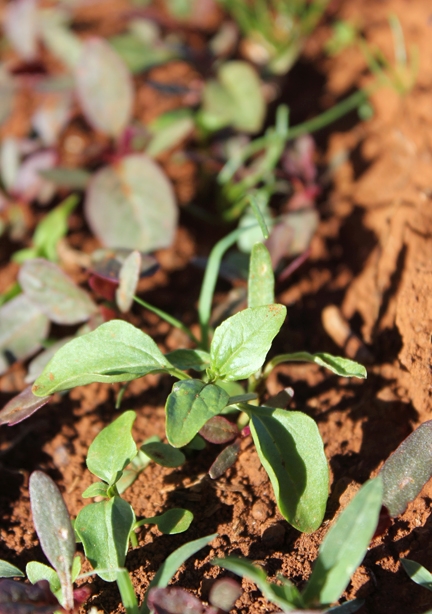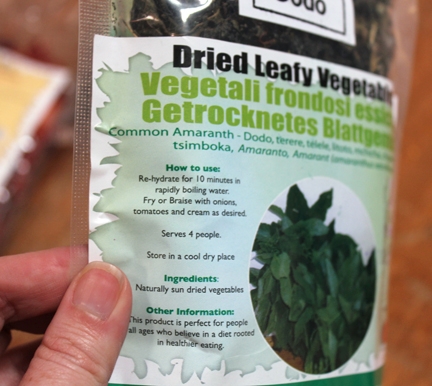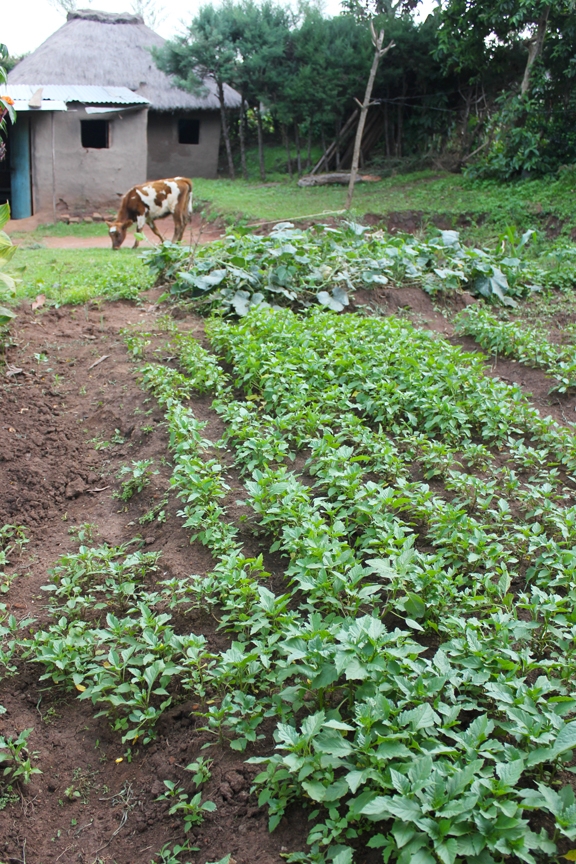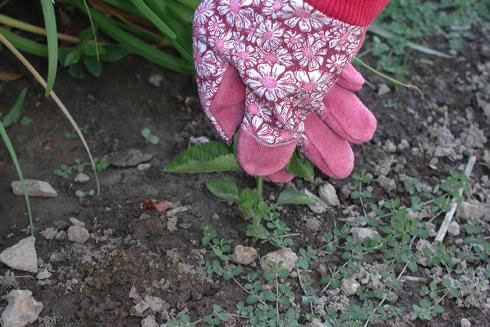Posts Tagged: weeds
When weeds make good eats
Last week, NPR offered up a novel weed control solution for all those yellow dandelions dotting your lawn: just eat 'em. The article includes a chef's recipe for dandelion flower fritters.
The idea that weeds can be edible pops up periodically, with articles suggesting one person's weeds are another person's salad bar, highlighting chefs who “have a way with weeds,” discussing ways medieval gardeners encouraged weeds, and even suggesting ways to eat away at invasive species. But is this something we should take seriously?
“We call these plants weeds because of the way we interact with them. They're in our gardens, they're in our lawns, and they're competing with plants that we prefer to eat,” said Lynn Sosnoskie, a weed scientist at UC Davis. “But a lot of the plants that are weeds here in the United States were brought here purposefully—to be eaten.”
Sosnoskie's doctoral thesis was on just such a plant, with the tasty name of “garlic mustard.” She has also worked at length on Palmer amaranth, a pernicious weed found in cotton fields that can be glyphosate-resistant. In response to one Georgia farmer asking in exasperation if he should just eat the plant taking over his fields, she did some preliminary research into eating Palmer amaranth.
“It's probably not feasible to eat our way out of a serious weed problem,” she said. “But I certainly feel like we can investigate them as other potential food sources.”
In fact, the Horticulture Innovation Lab at UC Davis has a project that is researching three “indigenous vegetables” in Africa, two of which — amaranth and black nightshade — are considered weeds in the United States. The vegetables can be nutritious and profitable options for small-scale farmers in Kenya, Tanzania, Zambia and elsewhere.
“I think some of these weeds have a lot of potential and are underutilized,” said Stephen Weller, horticulture professor at Purdue University, who leads the indigenous vegetables project. “In eastern Africa, these vegetables are very popular. And I really think that as we get more immigrants here from that region, there is going to be a market for some of these vegetables here.”
Though he holds a Ph.D. in weed science, Weller is now figuring out the best ways to cultivate amaranth and black nightshade — instead of to eliminate them. Before he started working with these plants, common assumptions held that they should be easy to grow because, well, they “grow like weeds.”
“But we found out that growing them is more intensive than we were initially led to believe — similar to growing any other vegetable,” Weller said. “They need water, they need fertilizer, and pests are a problem.”
Caveat emptor: Though weedy plants can indeed be a source of food, both scientists cautioned against thinking of weeds as a “free-for-all forage buffet.” Some plants may be toxic, and weeds in farm fields may have been sprayed recently. It is important to be knowledgeable of the plants and how they've been grown before trying to eat one.
Weeding: obstacle or opportunity?
Possibly the most distasteful task for gardeners is weeding. My UC ANR colleagues spend a good deal of time on the science of weed management, which represents a significant challenge for school, home and community gardeners (and for larger-scale agricultural producers). The UC ANR Master Gardener Program has excellent suggestions for school, home and community gardeners about how to reduce weeds.
This growing season, I've taken a more philosophical approach to weeding. It's all about falling in love with gardening, again, every time I work in one. You take the good stuff – vegetables and flowers – along with the weeds.
Most of my professional life has been spent in garden-based education: the practice of it, the teaching of it, and the history of it. When my daughter was younger, I spent six years as a garden volunteer for an elementary school. I moved on to working with middle schoolers, and have worked with high school students to plan and implement garden projects. I've also worked with community gardeners. My professional (and also a highly personal) mission is this: “A Garden for Everyone. Everyone in a Garden.”
Recently, I've found great joy in helping my church begin a congregational gardening project. It's a small and simple effort, but it has the wonderful feel and rhythm of summertime: longer days, a more leisurely pace, casual and unplanned meetings with new friends in the garden, and the feeling that there is more time to focus on tasks.
I live in an area where we are blessed with the ability to garden year round, but summer gardening has a particular feel to it that evokes wonder and memories of other summer gardens. (Cupping in my impossibly small hand a sun-warmed tomato grown in my grandparent's garden; eating that tomato with them that night at supper with cornbread. A summer I was in high school, when I grew watermelons in the desert; it took a lot of water, and all sorts of creatures liked the vines. Container gardening with my husband on the back stoop of our first small apartment. Helping my daughter plant carrot seeds and holding her small hand in mine after, the way older hands held mine).
Our congregational garden is tucked away behind a gate and a block wall, a small oasis of quiet in what in recent years has become a busy urban neighborhood. It's a good sunny spot, a great place to grow vegetables . . . and weeds. Saturday morning, I arrived early to beat the heat and pull a few weeds. I was somewhat dismayed when I surveyed how quickly they'd proliferated. Truth: overwhelmed.
But I got down to it and focused on weeding, pulling one at a time. My busy mind began to slow down. Alone in the garden, I listened to the sound of birds, the muffled city traffic and got some much needed exercise. Weeding provided an opportunity to reflect, to look at how the garden is progressing, to ponder about how we might grow our efforts, to consider that the pace of garden development is a season (not a day), and to anticipate the harvest we will reap. Weeding also provided a quiet time for me to think about what I want to accomplish over the summer months. At the end of an hour, I felt a sense of accomplishment and peace. And I realized that the weeds had not been an obstacle, but rather, had provided an opportunity for me to just be in the moment.
We plant gardens, and they produce wonderful things for us. Invariably, they also produce weeds. Whether we view them as obstacle or opportunity is our choice.
The author's latest book, Sowing the Seeds of Victory: American Gardening Programs of World War I, is available on the McFarland Publisher's website. Anyone who orders the book can message Hayden-Smith via her website, http://rosehayden-smith.com, to receive a signed WWI-design bookplate.
Are weeds taking over your garden?
My calendar says November but the weeds in my garden think it’s spring. That nice rain last month followed by warm, sunny days has prompted them to grow like, well, weeds and that’s not good news for my winter crops.
What’s a gardener to do?
Like so many other gardeners, I turned to the folks at the UC Davis Weed Science Program. Housed in the UC Davis Department of Plant Sciences, the “weeders” are experts at helping growers and gardeners improve plant production by controlling weeds.
What are the most effective organic tools for controlling weeds? That’s what I, and thousands of others, want to know. You don’t have to be an organic grower to seek organic tools for fighting weeds. Synthetic herbicides come with a cost to growers and the environment, so more and more farmers are seeing the value in employing organic tools with or without other means.
Which tools work the best in which situations? Here’s a quick overview, courtesy of Cooperative Extension Specialist Tom Lanini, who specializes in weed control in vegetable crops.
Mulches – Researchers test them all – plastic, bark, wood chips, other porous material, even what they call live mulches like clovers and fava beans. Mulches block light, which weeds need to grow. “I think mulches can be the best organic option for fighting weeds, especially for vines and trees,” Lanini says. Mulches are also a key weed-fighting component in organic strawberry and many other crops.
Organic sprays – Coverage is the key. “No matter what type you use – oils, soaps, acids, etc. – if you don’t spray-to-wet, 100 percent coverage, the weeds will grow back,” Lanini says. Temperature and the age of the weed matters too. Apply in temperatures above 75 degrees when weeds are very young – about a week old – for best results. Broadleaf weeds are easier than grasses to control with sprays.
The most effective organic spray Lanini has found so far is good old-fashioned vinegar, the kind you use to make pickles. The trouble with that is, the FDA has yet to approve it for controlling weeds. “You can eat it, but can’t spray it on your weeds,” as Lanini says. There are herbicides with vinegar as their active ingredient, but they are much more costly than household vinegar.
Flamers – These propane-fueled devices quickly raise the temperature of the weed to more than 130 degrees, rupturing its cell membranes. Grasses are hard to kill by flaming because the growing point is protected underground. Flamers require quite a bit of fuel, which can be costly.
Solarization has become an important method of weed and disease control in organic desert vegetable crops. In this system, four to six weeks of solar heat under clear plastic film will kill weed seeds and pathogen propagules.
Cultural practices are extremely important in all vegetable crops especially in organic crops. Crop rotations result in shifting environments that do not favor any one weed. Use of preplant irrigation followed by shallow tillage, or flaming is a very effective method of reducing the potential weed infestation during the crop cycle.
Weeding and thinning by tool or machine is a time-honored solution. Never underestimate the value of a hoe.
You can read more about the UC Weed Science Program here and access the Weed Research and Information Center web site here.
For more detail on weed management for organic vegetable crops, Click here.






